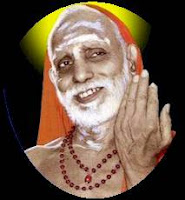
His Holiness, Sri Chandrasekharendra Saraswathi, the 68th Sankaracharya of Sri Kanchi Kamakoti Peetam in South India, passed away in Kanchipuram, Tamil Nadu, on Saturday, January 8th, 1994, just four months before he was due to complete his centenary. The end of the 68th pontiff of the Kanchi Mutt came suddenly at 2:58pm as he was relaxing in his room within the mutt. All of India rushed to pay respect-Hindus, Muslims, Christians, rich, poor, low caste and high caste alike.
The pontiff, slightly indisposed due to a phlegm formation, had stopped giving darshan to the public since the first of this year. But he recovered fully and was talking to devotees. He listened that final morning to a continuous recitation of the 1,000 names of Vishnu by 100 devotees. The two junior pontiffs, His Holiness Jayendra Saraswathi and his disciple Sri Vijayendra Saraswathi, met the pontiff around 2:30pm before leaving for Tambaram, a suburb of Madras. Informed in transit that the pontiff’s condition was serious, they rushed back to Kanchi mutt at 4:30pm, but he had already attained mahasamadhi. When informed of the end of his guru on his arrival at the mutt, Sri Jayendra was too shaken for some time to leave the van. After he collected himself, he ran in followed by Vijayendra. Three doctors-Bhaskaran, Ranganathan and Sambamoorthy-attended on the sage till he breathed his last.



































